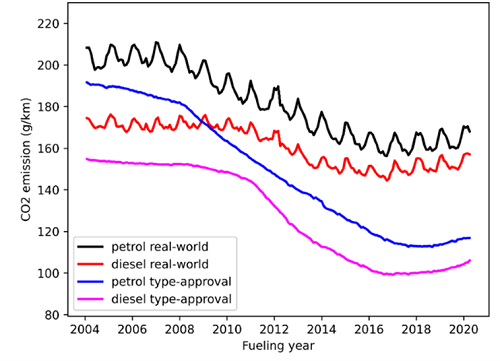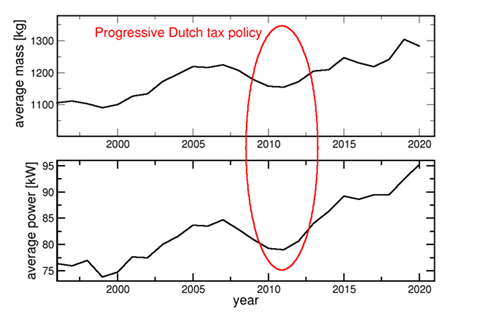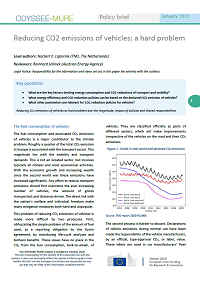Summary
Key questions
- What are the key factors limiting energy consumption and CO2 reductions of transport and mobility?
- What energy efficiency and CO2 reduction policies can be based on the declared CO2 emission of vehicles?
- What other parameters are relevant for CO2 reduction policies for vehicles?
Reducing CO2 emissions of vehicles as hard problem due the magnitude, impact of policies and shared responsibilities.
Lead authors: Norbert E. Ligterink (TNO, The Netherlands)
Reviewers: Reinhard Jellinek (Austrian Energy Agency)
The fuel consumption of vehicles
The fuel consumption and associated CO2 emissions of vehicles is a major contributor to the climate problem. Roughly a quarter of the total CO2 emission in Europe is associated with the transport sector. This magnitude lies with the mobility and transport demands. This is not an isolated sector, but involves typically all citizens and most economical activities. With the economic growth and increasing wealth since the second world war these emissions have increased significantly. Any effort to reduce transport emissions should first overcome the ever increasing number of vehicles, the amount of goods transported, and distances driven. The direct link with the nation’s welfare and individual freedom make many mitigation measures both hard and unpopular.
This problem of reducing CO2 emissions of vehicles is made more difficult by two processes. First, obfuscating the simple problem of the amount of fuel used, as a reporting obligation by the Kyoto agreement, by introducing life-cycle analyses and biofuels benefits. These issues have no place in the CO2 from the fuel consumption, tank-to-wheel, of vehicles. They are classified officially as parts of different sectors, which will make improvements irrespective of the vehicles on the road and their CO2 emissions.
Figure 1: Trends in real-world and declared CO2 emissions

Source: TNO report 2020 R11664
The second process is harder to discard. Declarations of vehicle emissions during normal use have been made the responsibility of the vehicle manufacturers, by an official, type-approval CO2, or label, value. These labels are used in car manufacturers’ fleet targets in European annual registrations. The declared values reduced more quickly since 2007 than the real-world fuel consumption, to a gap of 47 g/km for vehicles from 2018. (Figure 1)
Label values, CO2 and fuel consumption, are also at the centre of many policies for creating consumer awareness by member states regarding the fuel consumption and CO2 emissions of vehicles. These labels do not tell the full story. Moreover, the effectiveness of awareness campaigns is limited, especially because of the known difference between real-world fuel consumption and the label values. In many cases manufacturers, importers, and car dealers provide additional explanations, why the declared fuel consumption may not be achieved in normal use. There are a number of lawsuits, notably in Italy, over the fact that the label values are considered misleading information. Alternative labels, partly in collaboration with car manufacturers has further confused the issue. Including fuel-consumption awareness in driving instructions, i.e., eco-driving, is a second policy, of which the effects are limited due to the voluntary and generic nature of these instructions.1
For heavy duty vehicles similar trends exist, although generally not that well known. In the past the engine power of trucks was lower, in fact so low that there was a safety requirement of a minimal amount of engine power per tonne vehicle weight. Nowadays, this requirement is irrelevant, because of increase in engine power in trucks, by about 3 kW per year over the last 50 years. More engine power changes the driving behaviour of trucks and increases the losses with the same absolute power demand.
Consequently, most of the gains in engine efficiency in the last decades are lost in the increasing heavy duty engine power. It is estimated that per each extra kW of engine power about 0.05 litres of diesel per 100 km extra is consumed.
The vehicle CO2 emission standard
A CO2 label for vehicles must be based on an objective standard. This objectivity has been interpreted as a laboratory test protocol, to achieve reproducibility, in which all influencing factors are minimized. The test is already an ideal situation, without wind or auxiliary energy use, which was further optimized by car manufacturers to achieve low values, when these CO2 values became relevant for targets and taxes. With the new WLTP (World-Wide Harmonized Light-Duty Test Protocol), for CO2, more complexity is added to incorporate different options in the same vehicles, worldwide regional differences under the UNECE, and new measurement techniques used by the manufacturers, like wind tunnels. This has led to more options and more complexity, in which the danger lies that improper CO2 value declarations may go unnoticed.
For NEDC (New European Driving Cycle) the CO2 gap between the declared value and normal use has increased to almost 50 g/km. For the WLTP, from 2018, there is the clear risk the gap will increase too, with the test options and flexibilities open to the vehicle manufacturers. The European Commission is developing regulations, based on regulation EU/2019/631, to allow for control by independent verification and remedial actions on too low CO2 declaration of certain vehicle models, compared to results by independent tests. This is not in force yet, but it is expected to be finalized in the next year. The same regulation also includes the On-Board Fuel Consumption Meter (OBFCM), that provides the means and principles to collect real-world data on new vehicles. The question remains if more information will lead to any other conclusion than the ones based on current data, from vehicle fuelling.
An impossible decomposition of responsibility
Meeting general goals like reducing the national total fuel consumption from millions of vehicles can be approached from two directions. The top-down approach needed to ensure the whole problem is included, and bottom-up to make policies and measures specific and to understand specific limitations. These two ends seldom meet. It is very hard to survey the overall mobility and transport demands in terms of the associated energy demand and fuel consumption at individual vehicle level, in specific use, or at a specific locations.
Eventually, the fuel consumption and CO2 emissions are the result of specific use. This use will vary from owner to owner, season to season, and country to country. The deviations with the declared values are often attributed to the behaviour of the vehicle users. Typical variations are in the order of 30%, in both directions, so a major contributing factor the total CO2 emissions. Moreover, it makes it very hard to establish whether the declared manufacturer values are appropriate or not, based on real-world CO2 emissions. Some vehicles may be used in a manner further away from the laboratory standard set by Europe.
Eventually, the total fuel consumption is the actual contribution to the climate problem. With declared CO2 values the problem is unnaturally decomposed into a manufacturer part and an user part, and both may point to the CO2 emission standard and the test as not appropriate for the division of these two parts.2 The current situation does not lead to constructive collaboration.
The vehicle manufacturer, the car owner and the European Commission hold each other in a stronghold. They point out their responsibility is limited, and other parties are instead responsible for the excess in CO2 emissions. With three dissenting parties involved no easy agreement can be reached. Because no proper boundary can be drawn between three parties. There is always another party to point to for blame.
This situation is embedded in the European approach to reducing vehicle CO2 emissions. Despite the apparent lack of success, as indicated by the actual reported fuel sold every year, the approach is extended to heavy-duty and plug-in hybrid electric vehicles, which includes a lot of simulation and assumptions, for example about the distance driven electrically with plug-in hybrid electric vehicle (PHEV) .
The breaking up of a stable triangle
So, in order to solve this triple stand-off the triangle must be broken. One of the three parties, manufacturer, owner, and legislator, must be taken out of the equation, and separate bilateral agreements could be established. If the vehicle manufacturer is taken out of the equation, the car owner is solely responsible for the climate impact, proportional to their footprint. For its effectiveness, the transparency must be higher, so consumers have a choice both when buying and when using a vehicle. The OBFCM may help. However, similar climate actions have increased the social divide, with the wealthy who can afford to pay for CO2 emission reducing products and fees, while the poor cannot. It is important to set a standard for the individual rights to mobility and transport, and base the incentive on the excess in CO2 emissions, above the allotted share, or acceptable footprint.
Especially, the excess weight, size and power of cars, associated with comfort and status, beyond basic mobility demands, may be the part that could be taxed highest for its climate impact. Currently, fuel consumption in litre per 100 km can vary up to a factor of two. For some people the fuelling bill is a significant cost, while for others it will not play a role at all.
If, on the other hand, the car owner is taken out of the equation, and the vehicle manufacturer foots the fuel bill for many years or long distance, there is a true incentive for the manufacturers for both technological improvements and awareness campaigns for car users and car use, tailored to the vehicle’s technology, to retain a profit margin, by reducing this fuel bill. It would be most effective if it is based on an initial, yet substantial mileage, like 100,000 km. The fuel cost would be around 10,000 Euros, with a margin based on variations in real-world fuel consumption up to 4,000 Euros. Within the total vehicle price and costs this is not insurmountable, but significant enough to induce an effort to reduce fuel consumption.
Back to the physics of energy consumption
The type-approval, or declared CO2 value is hardly a discernible aspect of vehicle categories anymore. In the past the official CO2 emission was directly related to the size, weight, and engine power of the car. Nowadays, very large and exclusive cars may have very similar declared CO2 values as smaller, lower market segment vehicles. In part, this is due to the hybridization and fuel saving technologies that are applied in more expensive vehicles. This also makes the declared CO2 value less reliable for real-world CO2 emissions and fuel consumption. For example, when driving mainly 120 km/h, or faster, on the motorway, hybridization can be more of a weight burden increasing fuel consumption than a cause for lower fuel consumption.
So it may be better, when considering taxing or subsidizing vehicles, to return to the physical basis. Based on the analysis of fuel consumption data of almost half a million vehicles, it is concluded that weight is the key factor in real-world fuel consumption and CO2 emissions. About 70% of the fuel consumption is directly explained by, or correlated with, the weight of the vehicle. Another 17% is related to the type of fuel. A diesel vehicle of the same weight and age will have about 17% lower CO2 emission. But also, a diesel car of 200 kilograms more will have a higher CO2 emission than the small and lighter petrol car. A strong type-approval CO2-based policy will also reduce mass and power of vehicles. (See Figure 2.)
A third effect, which is often overestimated because of the ever decreasing type-approval CO2 values, is vehicle age. A significantly younger car, say 10 years younger, will reduce the CO2 emissions of a vehicle of the same weight and fuel by about 13%. The improvement of engine efficiency is a more or less autonomous process of about 1% CO2 reduction per year, largely unrelated to CO2 targets and incentives.
Figure 2: Dutch CO2 based tax policies reduced average vehicle weight and power between 2008 and 2012

Source: adaption of RDW open data
So making vehicle weight a key factor in policies will be an effective measure. Rather than relying on the correlation between type-approval and real-world CO2 reduction, it is based on simple physical principles that moving and accelerating less weight will require less energy, and less energy requires less CO2 in principle, irrespective of fuel and age of the vehicle.
Two key factors in heavy cars and, therefore, high CO2 emissions are the safety and motorway speed limits. The heavier the car, the safer one generally is, at the expense of other road users. The high velocities on the motorway adds another risk factor that lead to heavy and high powered vehicles. Heavier vehicles need higher power in order to achieve the same drivability, but, generally power-to-mass ratio also increases with the vehicle weight. Moving back to lighter, more energy efficient vehicles with the same safety is best supported by reducing the speed limits on the motorway, to 100 or 90 km/h. The instantaneous effect of CO2 emissions on the existing vehicle fleet is another very large benefit, which can easily lead to a 10%-20% CO2 reduction in the existing fleet.
It should not be underestimated that new vehicles last longer with every year, about 3 months of extra lifetime per year. Current scrappage age is about 20 years. Vehicles sold now, in 2020, are expected to last at least 25 years, till 2045. So, any measure only aimed at new vehicles will have a limited effect on the CO2 emission reported according to the Kyoto agreement until 2030 or 2035. Any policy measure aimed at existing vehicles as well as new vehicles has double action: reducing emissions on the current fleet, and steering consumers towards the vehicles with low CO2 emissions, based on this experience.
Concluding remarks
To achieve a reduction of CO2 emissions of transport and mobility, against the increased demand of mobility and transport, effective policy measures are needed. The current situation is a deadlock, and the experience of ten years of climate action for road transport has shown that the current approach is not very effective. On the other hand, full electrification of road transport is neither a quick nor a complete solution. The existing fleet must be taken into account as well. Such ambitious policies should not alienate people. Moreover, purely financial incentives may increase the social divide and erode support for necessary climate actions. Generating awareness by information and education, engaging responsible parties, and reducing energy consumption by policies based on physical principles for the whole fleet should replace policies based solely on CO2¬ certification values of new vehicles.
Notes
- 1: https://www.measures.odyssee-mure.eu/energy-efficiency-policies-database.html
- 2: TNO Report 2016 R10419 on decomposition
For further reading or information, please visit https://www.odyssee-mure.eu/






